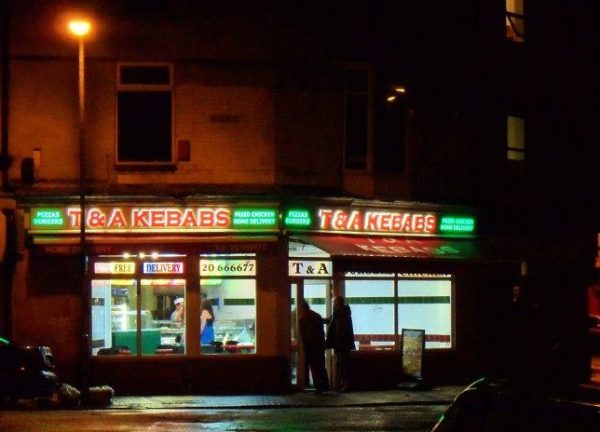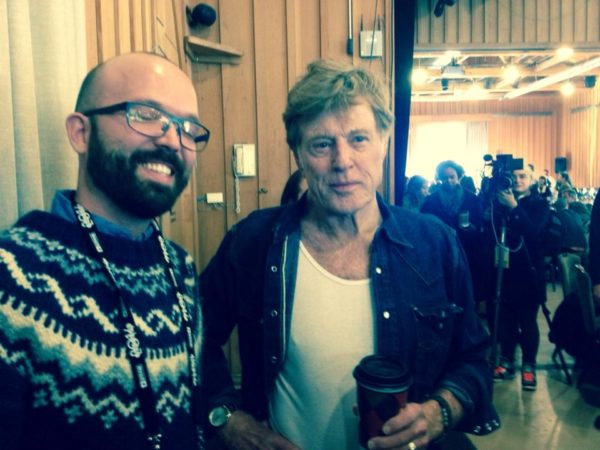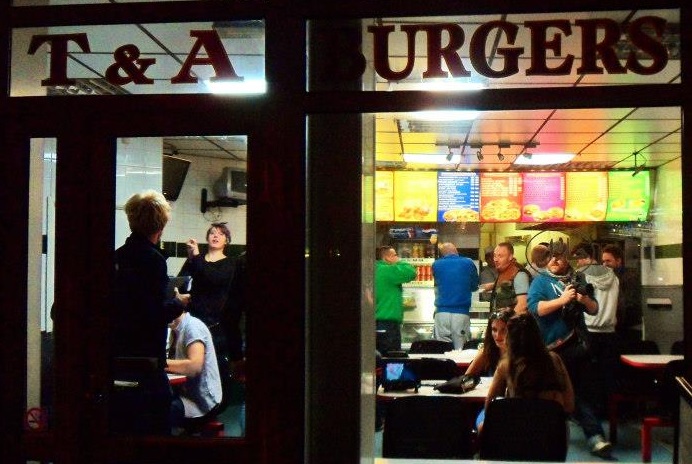November 1st 2012 - 11:15pm
It's Friday night and I'm standing on the corner of T&A Kebabs in Roath. A young man approaches me, his face covered in blue felt-tip, like some Celtic warrior daubed in woad. Except in his case, it's less "warpaint" and more "top bantz". "I'm sorry," I tell him. "Shop's closed. They're making a film." "Then where's the ****ing camera?" he asks, indignantly. The camera is clearly visible through the window. It is both enormous and expensive. One of its more recent gigs was the Bond movie Skyfall. "It's right there," I tell him.Budget Braveheart is having none of it. He tries barging into the kebab shop, I stand in his way, there's a scuffle that's about as violent as an episode of Peppa Pig, and he stumbles off, his appetite unsated.
Almost seven years later this is my abiding memory of the making of Burger, the fourth film produced by the Iris Prize. Rehearsals lasted almost a fortnight, but shooting on location in a real-life kebab shop meant that every shot, every take, every line of dialogue had to be captured in a single night. T&A agreed to close for the night, but - to the passing reveller in search of carbs - it appeared open. My job was to stop them stumbling through the door mid-take. Cinéma vérité has its limits.
 A nearby gastropub was commandeered, providing food for cast and crew and a base for the second unit. The first unit were crammed into the sweltering heat of the kebab shop's narrow kitchen, and ceiling tiles were removed so that extra lighting could give the place a suitably Edward Hopper-ish vibe.
A nearby gastropub was commandeered, providing food for cast and crew and a base for the second unit. The first unit were crammed into the sweltering heat of the kebab shop's narrow kitchen, and ceiling tiles were removed so that extra lighting could give the place a suitably Edward Hopper-ish vibe.
Why 'Burger'? Why a kebab shop? To answer that, we'd have to wind the clock back to October 2011. Magnus Mork is in Cardiff for the first time, having won the previous year's Iris Prize for his film Samaritan. After a night on the town he's taken to Caroline Street, aka Chippy Lane, famous/notorious for its chip shops, kebab shops and inebriated people struggling to stand up and eat at the same time. For Magnus, it was an epiphany.
Cut to: November 2012, and I'm on that street corner in the icy drizzle. Actors are shepherded to and from the kebab shop beneath umbrellas. Across the street, Roath nightspot "Koko Gorillaz" gets progressively louder and louder until the landlord calls time. There are further unsuccessful attempts by passers-by to get in to the shop.
 It's getting light by the time we finish filming. Bundles of newspapers appear in newsagents' doorways. Having stood on the same spot for the last ten hours my legs are in agony, and if I never see the signage of "Koko Gorillaz" again, it'll be too soon. But apart from hearing one or two lines of dialogue, I have no idea what the film will be like.
It's getting light by the time we finish filming. Bundles of newspapers appear in newsagents' doorways. Having stood on the same spot for the last ten hours my legs are in agony, and if I never see the signage of "Koko Gorillaz" again, it'll be too soon. But apart from hearing one or two lines of dialogue, I have no idea what the film will be like.
Even so, something about the night's energy, the enthusiasm of the cast and crew, inspires confidence. And sure enough, the film is a triumph. It's a Cardiff film, a proper Caaahdiff film, something I'd never seen before - all the more remarkable, given that it was made by a Norwegian. It captures that moment, at the end of the night, when disparate people find themselves in the same starkly lit places. All of humanity is there, in the neon glow and the sizzling, gyros-scented confines of a kebab shop.

Watch 'Burger'
If you're on this year's shortlist, you could find yourself making the next Burger. Or indeed, the next Colonial Gods, the next Involuntary Activist, the next Spoilers. To date, ten short films have been directed by Iris Prize winners, with the eleventh now in post-production. The director of the first, Dee Rees, went on to write and direct the feature films Pariah and Mudbound, and in 2018 became the first woman of colour to be nominated for the Academy Award for Best Adapted Screenplay. So no pressure.
Anyway, if you do find yourself directing an Iris Prize Production, and in the unlikely event that I get asked to do nightwatchman duties, could I just ask that we please shoot it somewhere a bit more glamorous than a kebab shop, and a little bit warmer than a Roath street corner in November?
Picture descriptions:
- An image from the film 'Burger'. Three men in sportswear are standing at the counter of the kebab shop featured in the film. The focus us on a man with a shaved head in profile. His friends stand either side of him. One of them has a visible tattoo on his neck.
- A photograph taken during production of the film. See through the window of the shop location, various members of the cast and crew between takes.
- A shot of the kebab shop, named T & A Kebabs, taken at night from across the street. The shop is brightly lit, with red and green signage.
- A screenshot of a tweet from David Llewellyn, the author of this blog post, which was posted on the night of the shoot. It is written in the style of a script, as follows. "Me: Sorry, mate. The kebab shop's shut for a film shoot." Ron Jeremy lookalike: "You mean I can't even buy an effing samosa?" Hashtag Showbiz.
- A photo of the director, Magnus Mork, in a very wintry jumper, standing next to Robert Redford, at the Sundance film festival.

